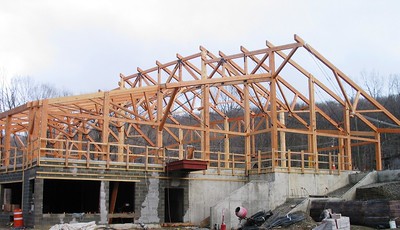Heavy Timber Construction: A Traditional Technique in Modern Building
What is Heavy Timber Construction?
Heavy timber construction, also known as mass timber or post-and-beam construction, uses large wood beams, columns, and planks to create structural frameworks. This construction type utilizes wood elements at least 6 inches in thickness, creating a highly durable and fire-resistant building structure. Heavy timber is often combined with other materials to provide a strong and stable framework for various building types, especially in commercial and residential settings.
History of Heavy Timber Construction
Heavy timber construction has ancient origins, dating back centuries in Europe and Asia. In early American history, timber was one of the most abundant resources, making it a common choice for construction. Timber framing rose in popularity in the 19th and early 20th centuries for warehouses, churches, and industrial buildings. With the rise of concrete and steel, heavy timber lost some ground, but today, growing interest in sustainability and renewable materials has re-popularized it in modern architecture.

Opportunities in Heavy Timber Design
Heavy timber construction presents unique advantages that cater to both environmental and aesthetic demands in modern architecture:
- Sustainability: Timber absorbs carbon dioxide, making it a low-carbon material compared to concrete and steel.
- Aesthetic Appeal: The exposed wood structure brings warmth and a natural look to buildings, enhancing design possibilities.
- Fire Resistance: Surprisingly, large wood beams char on the outside when exposed to fire, forming an insulating layer that preserves the core.
- Strength and Versatility: Heavy timber can bear significant loads and is suitable for multi-story construction, making it a strong option for diverse building types.
Challenges of Heavy Timber
Although heavy timber has many advantages, it also presents certain challenges:
- Cost: Timber framing costs can be higher than steel or concrete, especially for large buildings.
- Regional Sourcing Limitations: Not all areas have easy access to sustainably sourced timber, which may drive up costs and logistical issues.
- Construction Codes: Many building codes restrict the use of heavy timber for high-rise buildings, though changes in codes are underway in some areas.
- Moisture Sensitivity: Timber can be vulnerable to moisture, requiring careful weatherproofing and sealing techniques to ensure longevity.
Future Applications of Heavy Timber Construction
Heavy timber has a bright future, especially as architects and engineers push for more sustainable and renewable building options. Already, designers have begun exploring timber for mid-rise and high-rise buildings in urban areas. Advances in cross-laminated timber (CLT) and other mass timber products provide strength and fire resistance, expanding timber’s application in more extensive and taller structures. Heavy timber’s potential to reduce carbon emissions and create energy-efficient buildings positions it as a key material in the construction industry’s future. EVstudio Specializes in both the architecture and structural engineering necessary to get the most out of Heavy Timber Design.

Companies Specializing in Heavy Timber Products
Several companies specialize in heavy timber, providing materials and expertise in its application:
- Smartlam: Supplies mass timber products and has projects across North America. Visit Smartlam’s website.
- Nordic Structures: Known for its CLT and glulam products, Nordic Structures supports sustainable building practices. Visit Nordic Structures’ website.
- Timberlab: An innovative company focusing on mass timber solutions for mid-rise and high-rise buildings. Visit Timberlab’s website










